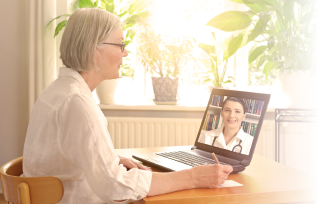
Agenturfotografin / shutterstock.com
Telerheumatology—which refers to the application of electronic communication technology to clinical encounters from a distance between rheumatologists and their patients—has the potential to extend a workforce projected to experience significant shortfalls, making it more accessible to more patients. Multiple barriers that stood in the way of taking full advantage of this promise are now down—at least temporarily—due to the demands of treating patients during the COVID-19 pandemic and the need to minimize personal contact during social distancing.
Pre-COVID-19
For the past nine years, Michael Rezaian, MD, a rheumatologist in independent practice at the Rural Outreach Arthritis Center, Martinsburg, W.Va., and his partner have provided specialist rheumatology consultations for a charity hospital in northeastern Iran that serves refugees from the war in neighboring Afghanistan. They also consult remotely on patients in Kathmandu, Nepal, and in Danlí, Honduras. Their experience with more than 4,800 patients in Iran over five years for remote evaluation and treatment of rheumatologic and musculoskeletal diseases is described in a study published online in 2019 in Telemedicine and eHealth.1
Telemedicine can make a big difference for patients with inflammatory, rheumatoid and psoriatic arthritis, Dr. Rezaian says. He also sees a fair number of children with juvenile idiopathic arthritis. “We use Skype primarily. It’s secure and private, and when the bandwidth decreases, you don’t get a pause in the signal, as sometimes happens with FaceTime.”

Dr. Rezaian
But he had not offered the same kind of remote service in rural West Virginia, where his clinic practice is located, because his malpractice insurance provider told him it would not cover it. “It used to be the equipment was the biggest barrier, but then Skype and smartphones came along,” Dr. Rezaian says. “Now, malpractice is our biggest impediment—although we have shown that telerheumatology can be done for many patients I have never seen in person.”
Editor’s note: As this article was going to press, Dr. Rezaian heard from his malpractice insurance carrier that it would be willing to start covering him for providing telemedicine services to patients in the U.S. In the midst of shelter-in-place orders, he reports that, except for emergencies, he is now doing telemedicine only, which is going well.
Dr. Rezaian sees international patients remotely three days a week, providing second opinions for those who have been told they need surgery. “They bring their MRI [magnetic resonance imaging] or X-ray results, and we are able to offer an opinion on whether surgery is really needed.” A general practice physician and nurse on the ground at the charity hospital help facilitate these encounters.
Dr. Rezaian provides this service free of charge. “It’s a good Samaritan thing, and very rewarding to me personally,” he explains. The service also incorporates medical residents from West Virginia University, Morgantown, who rotate through his clinic. When the service started, Dr. Rezaian visited Iran three times a year for a week at a time to support the local doctors and provide in-person patient visits, but he has since cut back on the travel.
“With high-definition images I can see the patients clearly. Sometimes we might ask the physician on the ground to put the patient through range-of-motion exercises. We ask a lot of questions and then try to figure out the best plan for their care,” he says. Diagnostic tests conducted on these patients include serologic tests, radiographs, MRI and bone densitometry. “Obviously, we can’t do injections remotely, but during our in-person visits we trained the local doctors to do [injections].”



